The Falkland Islands have become a popular addition to many Antarctic & South American cruise voyages. The Falklands’ amazing wildlife is the big draw, dazzling visitors with marvelous penguin, seal and albatross populations. And, yes, the adorable penguins are always crowd favorites!
Because the Falklands have a unique sub-Antarctic ecosystem, the islands are home to more than 220 species of identified birds – which includes over 60% of the world’s black-browed albatrosses. Plus, there are five different species of penguins found here – the gentoo, king, macaroni, Magellanic and rockhopper.
I visited the remote Falkland Islands in March 2017 on the Hurtigruten ship MS Fram, as part of an expedition cruise to Antarctica & South Georgia. We spent 2 ½ days exploring the fascinating island archipelago situated in the South Atlantic Ocean, approximately 400 miles off the tip of South America.
The Falkland Islands were our final stop before sailing back to South America. On our first day, we visited the charming and very British capital of Stanley, located on East Falkland. I’ve written a blog post about Stanley and all the fun things a visitor can do there. I also mention the 1982 Falklands War, in case you might be wondering!
West Falklands & the Outer Islands
West Falkland is the second largest island. It’s home to some of the best scenery, just a few people, and an abundance of wildlife. Apparently, a popular local catchphrase is the “West is Best!” There are a variety of small outer islands scattered around the edges of the two main islands.
Many of the smaller cruise ships (expedition types, like mine) visit one or more of the outlying islands. Unlike large cruise ships, they can anchor offshore and ferry passengers to land by small zodiac boats. The Falkland Island’s main tourist season runs November to March which falls, of course, during their summer.
My Visit to the Nature-Filled Outer Islands
After a full day of touring Stanley, we said our goodbyes and sailed to West Falkland. Over the next two days, we visited three of the Falkland’s outlying islands – New Island, Carcass Island and Saunders Bay. All are located on West Falkland’s west side. (see map)
Each of the three “island excursions” provided us with a very different but rewarding experience. Two featured exotic birds and different species of penguins. In contrast, the third excursion primarily filled our tummies!
And, believe me, you do not need to be a “birder” to be awed by the Falklands’ bird life – the penguins and seabirds are truly wonderful!
Blog Post Focus – The Outer Islands
In this blog post, come join me as we visit three of the Falklands’ Outer Islands. These particular excursions or “landings” (in expedition cruise speak!) are very popular ones. My post’s Photo Gallery should give you a good feel for what a cruise visit to these more rugged outer islands would be like.
A big thank you to Esther Kokmeijer, the Hurtigruten ship’s talented photographer from Holland for many of the wonderful photos shown below – all with credit given, of course!
Perhaps, if you are planning a future trip to Antarctica, you may be wondering whether to include the Falkland Islands – or even South Georgia. There is certainly no one right answer! But, I hope these Falklands’ posts (plus my post on South Georgia) will help you make the best decision for you! Let’s begin..
Visit #1 – to New Island
We awoke that morning to gale force winds as we prepared for our first “landing” at New Island. The ship dropped anchor near Settlement Harbor – and luckily, the winds abated enough to travel safely to shore. However, the winds and rough seas did make for an exciting zodiac boat ride!
Today, New Island is entirely a nature reserve run by the New Island Conservation Trust. The best wildlife experience is a short (~1km) walk “across” the island to the precipitous sea cliffs of the western coast. That’s the location of the vast Settlement Rookery, where we visited amazing colonies of rockhopper penguins, black-browed albatrosses, and king cormorants.
Our ship, the MS Fram, is in the background, as one of the red zodiac boats nears the small landing area. You might see the sea’s white caps better when you enlarge the photo!
This is a great view of our “wet landing” via zodiac boat, ably assisted by wonderful members of our ship’s expedition team (in red jackets). Everyone wore their tall rubber expedition boots. We ship passengers wore our bright blue Hurtigruten expedition jackets (see below)!
As we left the landing area, we immediately passed by a few houses/buildings. The island’s first “settlement” was here in 1860 – the people were mostly sheep herders. Today the island’s few “residents” are primarily wildlife researchers working with the nature trust.
Part way through our ~1km (0.6mile) walk from the harbor to the Rookery- passing through areas of tussock grass. You can see our ship out in the harbor.
- Click on all photos to enlarge
Above is the Striated Caracara, known locally as the Johnny Rock. It is one of the world’s rarest – and some say most aggressive – raptors (aka, birds of prey). However, this guy (above) was quite friendly to us – flying right above us and then landing close to us without any fear.
However, where the caracaras really like to hang out is near rockhopper penguin colonies, where they are looking for their next meal of a baby penguin during the breeding season. The rest of the year, they feed on carrion (the decaying flesh of dead animals) and small animals.
We’ve now arrived at the Settlement Rookery, where thousands of rockhopper penguins are spread out over the steep, rocky terrain. They head down to the sea, when it’s time to feed.
So, where do these distinctive penguins get their name? Nat Geo says: Rockhoppers are found bounding—rather than waddling, as most other penguins do—among the craggy, windswept shorelines.
We were able to get quite close to the Rockhopper penguins to observe them and take photos. However, the almost gale force winds continued while we were here so holding our cameras steady was a bit comical at times!
Here is a mating pair of Rockhopper penguins. Aren’t they adorable? And, don’t you just wonder what she is whispering in his ear?
Note the rockhopper’s typical red-orange beak, pink webbed feet, and their “punk hair-do” (my term, not the scientists!). They have straight thin yellow eyebrows with yellow plumes hanging above and behind their red eyes.
This rockhopper is “molting” – a process where old feathers are shed each year. The new feathers grow under the old ones, pushing them out. The molt is patchy and can give individual penguins a scruffy look. Plus, it keeps them out of the water until their new sleek swimming feathers are in.
Another view of the vast Settlement rookery – filled with rockhoppers!
A mating pair of the beautiful black-browed albatross.
A black-browed albatross taking flight & showing its amazing wingspan – which can be up to 7-8 feet!
An adult black-browed albatross (pink beak) in the rookery amongst three juvenile chicks (with black beaks). The nests are also interesting – they are a solid pillar made of mud and guano with some grass and seaweed. These nests are reused every year because the albatrosses return each year to breed (September-April), usually with the same partner.
Albatross feeding time – the parent collects the food, then regurgitates it for the hungry chick. The young fledglings are covered in a soft grey down but by April, they have grown their adult plumage and are abandoned by their parents. After a few days, they leave the nest to fly out to sea on their own.
It was fascinating to see the peaceful “co-existence” of rockhopper penguins & black-browed albatrosses in the Rookery – truly sitting side by side. Here one of the juvenile albatrosses is spreading and exercising its wings, preparing for when it’s time to fly. You can see the amazing wing span of this very special bird!
Here is a pair of King Cormorants, another beautiful sea bird. Also known as King Shag, Imperial Shag, Blue-eyed Shag or Blue-eyed Cormorant – take your pick!
It’s hard to see in the photo but they have a blue ring around their eyes. What is easy to see is the orange-yellow nasal bob above their bill. They breed in dense colonies on gentle cliff-top slopes around the Falklands.
Ah, yes – another Striated Caracara keeping a watchful eye over the rockhopper penguin colony, looking for any unprotected babies!
Visit #2 – Carcass Island
Unlike the last excursion which was filled with wild nature, our visit to Carcass Island was much tamer – and filled with sweets. It took 3 hours to sail the 40 miles from New Island to Carcass Island, arriving in time for a late afternoon visit.
Once safely ashore by zodiac, it was a 10-minute walk to our destination – the property of Rob & Lorraine McGill & their Carcass Island Lodge. Along the way, we passed a small colony of Magellanic penguins. I was excited because I hadn’t seen this penguin species yet!
The McGills, who own all of Carcass Island, have lived here for over 35 years. They operate the Carcass Island Lodge, a simple B&B, surrounded by beautiful scenery and abundant wildlife. The original farmhouse now houses the Lodge’s five guest rooms. Apparently, large colonies of Magellanic penguins even nest beneath the McGill’s home.
The Carcass Island Lodge staff was waiting for us – ready to serve afternoon tea, coffee and a variety of delicious treats! Unfortunately, we didn’t get to meet the McGills, but we were graciously hosted by Chilean staff members Roldan & Eva and others. It seems that other small cruise ships also make a visit to Carcass Island for a taste of the local Falklander’s warm hospitality.
View of Carcass Island Lodge & McGill family property – as we walked from the landing site. Our destination is the red-roofed building partially hidden in the trees – on the right.
A small colony of Magellanic Penguins. They breed in large or small colonies, burrowing into soft soil or peat on slopes facing the sea. They’re shyer than the other Falkland penguins.
Close-up view of a Magellanic penguin. They have conspicuous black and white bands on their head, neck and breast. Their stout hooked bill is grey and black, and there is pink skin around the eye. They’re closely related to the African Penguin.
This was the beautiful spread that greeted us at the Carcass Island Lodge. It was a cool, drizzly, windy afternoon so it felt great to go inside to get warm. Let the feeding frenzy begin!
Her apron says it all – meet “Jeannette – Carcass Island Baking Queen!” Yes, this lovely lady is the wonderful baker who created all these delicious treats for us hungry ship passengers.
Meet Roland & Eva, the friendly Carcass Island Lodge staff, originally from Chile. They were busy in the kitchen serving coffee and tea!
Visit #3 – Saunders Island
Our final landing in the Falklands – and of the entire trip – was on Saunders Island. And it was a picture-perfect ending! The weather had warmed, the high winds the day before had finally calmed, and the long, white smooth sand beach there was stunning!
Plus, the beautiful scenery was equaled by the wildlife! Here, in one place, we got to see all four types of penguins seen at various times during our entire trip. There were Gentoos, Kings, Rockhoppers and Magellenic penguins. Plus, for good measure, we added in some sheep grazing on the grassy hillside. It was a photographic jackpot!
We landed on the island near a narrow isthmus with a beach on each side. You can see our rocky landing area in the upper left (the red patch) plus below. After taking a short walk over to the first beach, we were greeted by hundreds to thousands of Gentoo penguins spread out over a large area of the beach.
This was the Saunders Island rocky “wet landing” area. The rocks were slippery but the expedition team (in red jackets) put down a rug for us to walk on. Yes, we were coddled! You can see our ship to the upper right – to give you an idea of how far our zodiac ride from ship to shore was.
Here’s a good view from the top of the big hill where the Rockhopper colony is located (just behind me as I took the photo). Below, you can see the beautiful long sand beach on the right with the narrow isthmus of land in the middle and the small bay with beach where we landed (in the upper left).
My friends Nadia & Steve are photographing Gentoo penguins on the gorgeous beach. To the upper right, is the hill leading up to the Rockhopper colony.
Yep, these Gentoo penguins are so darn adorable – I never tired of watching them! They loved frolicking on the beach and in the surf! As a California beach girl, I felt right at home here!
Closeup of three Gentoo penguins. It was great – they had no fear of us. Gentoos were the main type of penguin we saw a lot of in Antarctica!
There were hundreds of Gentoo penguins, clustered in different areas of the beach. Many were “molting” so the ground was covered in white feathers. Adult gentoos can take three weeks to molt. During this time, they can’t feed themselves because they can’t go in the water to fish. So, they’re hungry and miserable – plus their feathers itch!
Of course, I had to get the “I was here in the Falklands with the Penguins” shot to prove it!
This pretty bird is a male Upland Goose. The female – whose head is just visible at the left of the photo – is brown. Makes it really easy to tell the genders apart!
View of the Rockhopper Penguin colony at the top of the hill.
More Rockhopper penguins – my 2nd favorite penguin after the gentoos!
Here’s a Magellanic penguin (one also seen at the top) – near his burrow in the ground. The Magellanics are a summer visitor to the Falkland Islands – and are found all around the coastline where the ground is suitable for burrowing. Besides protection, we were told they burrow to stay cooler.
In the foreground is a King Penguin “maternity ward” – which sits at the edge of a Gentoo penguin colony. There are a total of 9 King mothers – 3 with fuzzy new babies (between 2-4 weeks old) and the other 6 still keeping their one egg safe & warm.
King Penguin on the left is guarding her around 4-week old fuzzy dark grey chick – while the other two penguins are standing guard over their soon-to-hatch egg – delicately placed under their raised up feet for warmth and safety!
Proud new King Penguin mother with her fuzzy new baby.
Nature is amazing, isn’t it!? Babies of all species are so darn cute – certainly this is true for penguin babies!
New penguin chicks are hungry – and always squawking for food – whether from their mom or their nearby aunties!
And, yes, here are those sheep I mentioned before – grazing close to all the penguin action. Sheep farming is an important industry in the Falkland Islands – with over 500,000 sheep!
Here’s the final Saunders Island photo. I thought it was a fitting goodbye with our ship in harbor, watched over by large colonies of Gentoo penguins! I’m sure I saw the penguins “waving goodbye” as we boarded our zodiacs to head back to ship.
To Learn More, Check out my Other Blog Posts:
- A Visit to the Falkland Islands & Its Charming Capital Stanley
- Fascinating South Georgia: Land of King Penguins, Shackleton & Rich Whaling History
- Falling In Love With Antarctica – Highlights of My Recent Polar Expedition
Falkland Islands Tourist Board Website – excellent information
COMMENTS: Have you visited the Falkland Islands? Did you make it to any of the Outer Islands? What did you think?

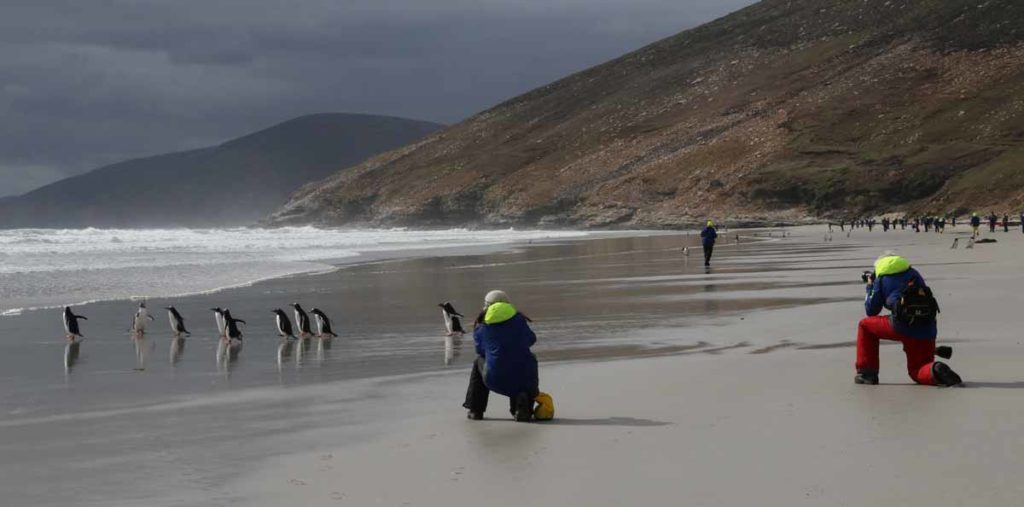
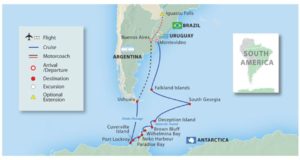
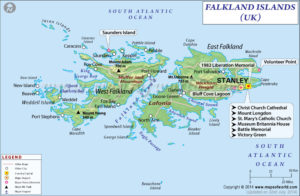
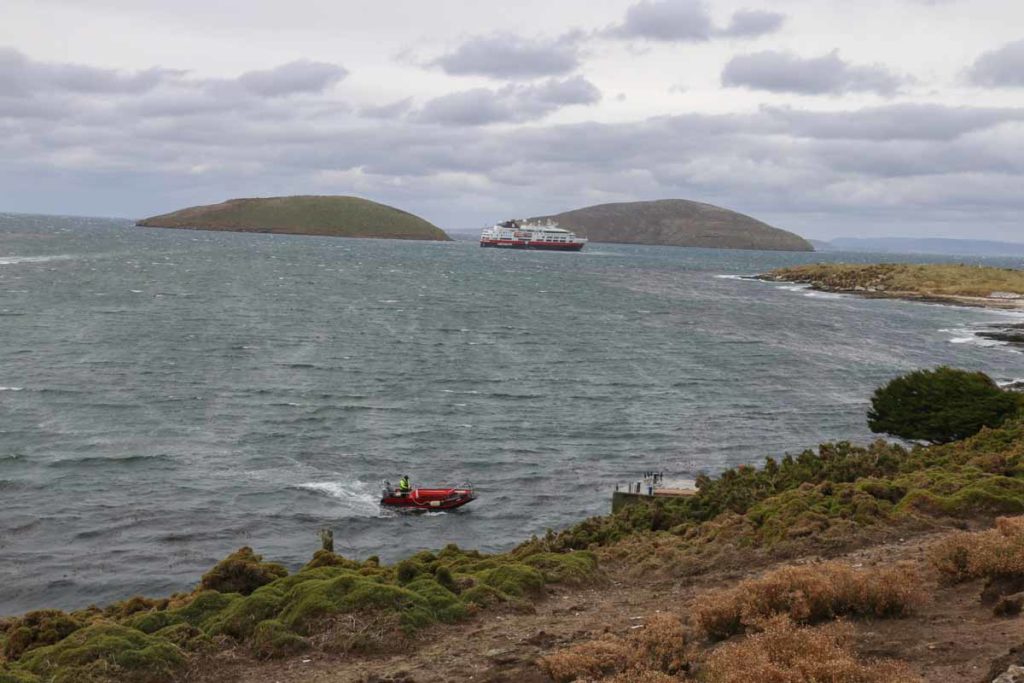
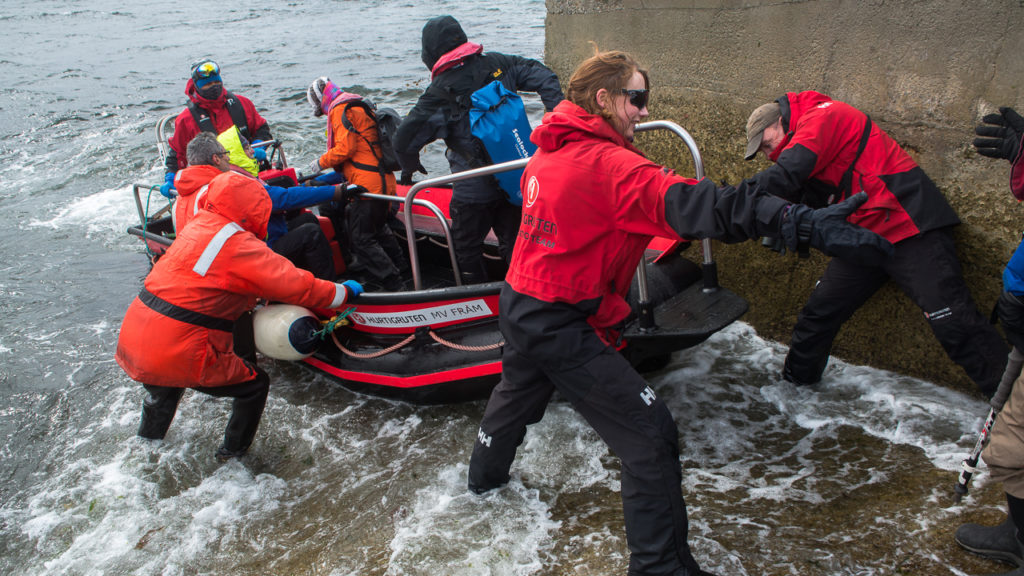
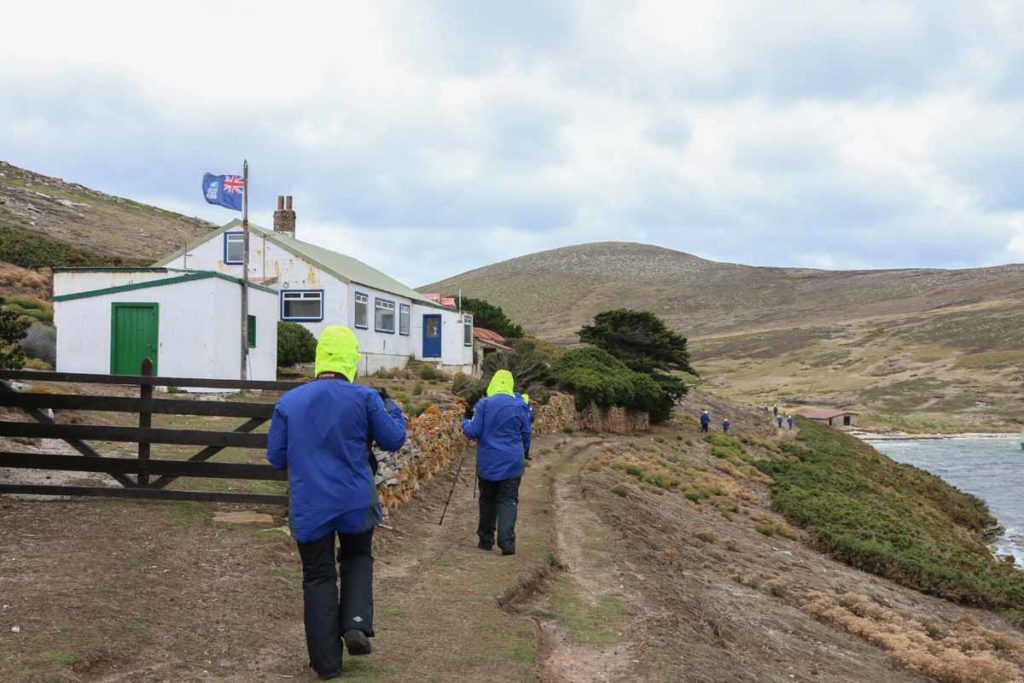
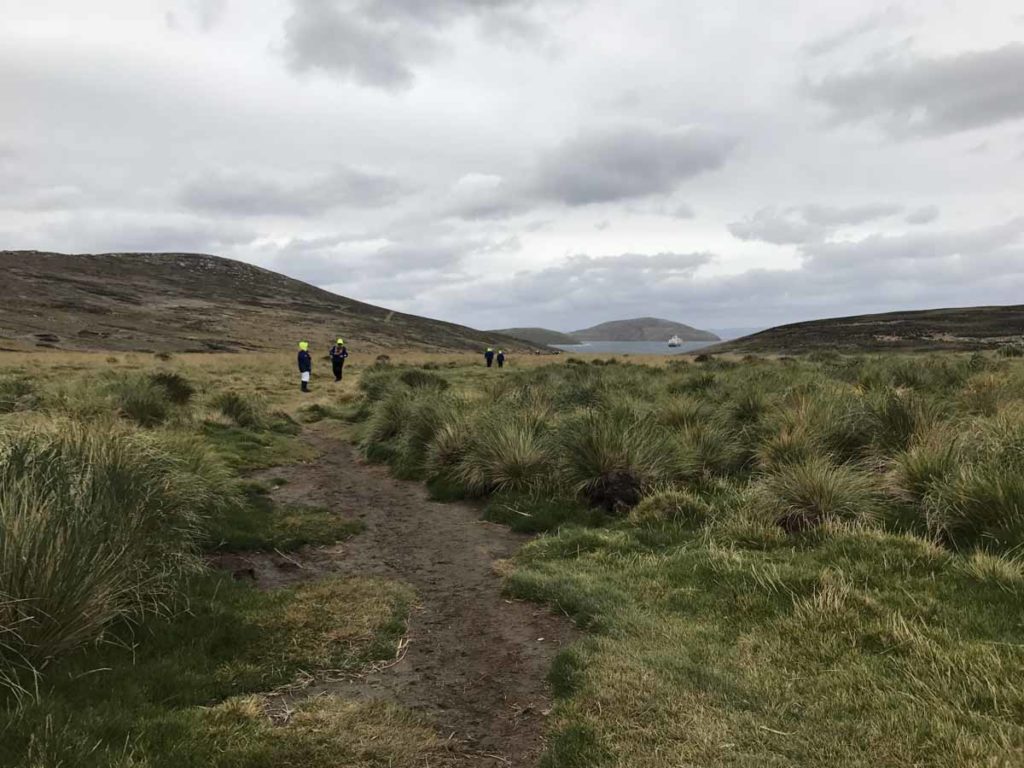
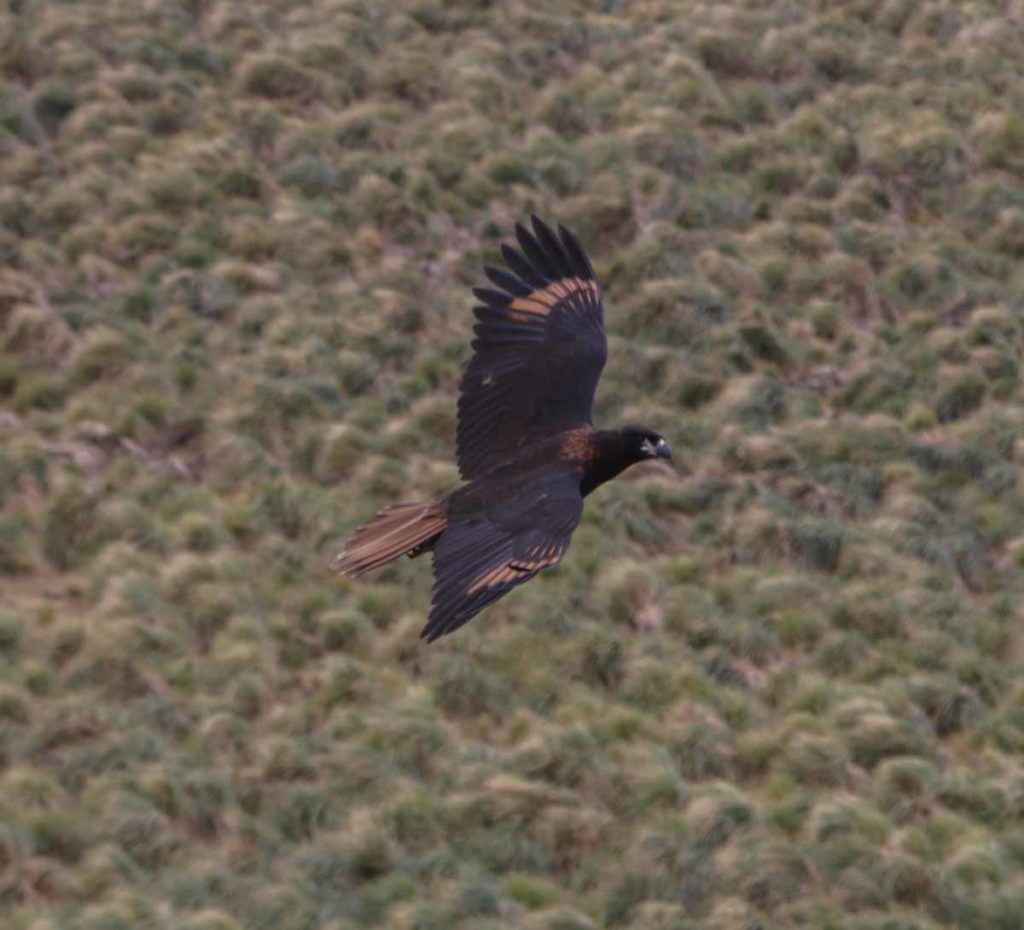
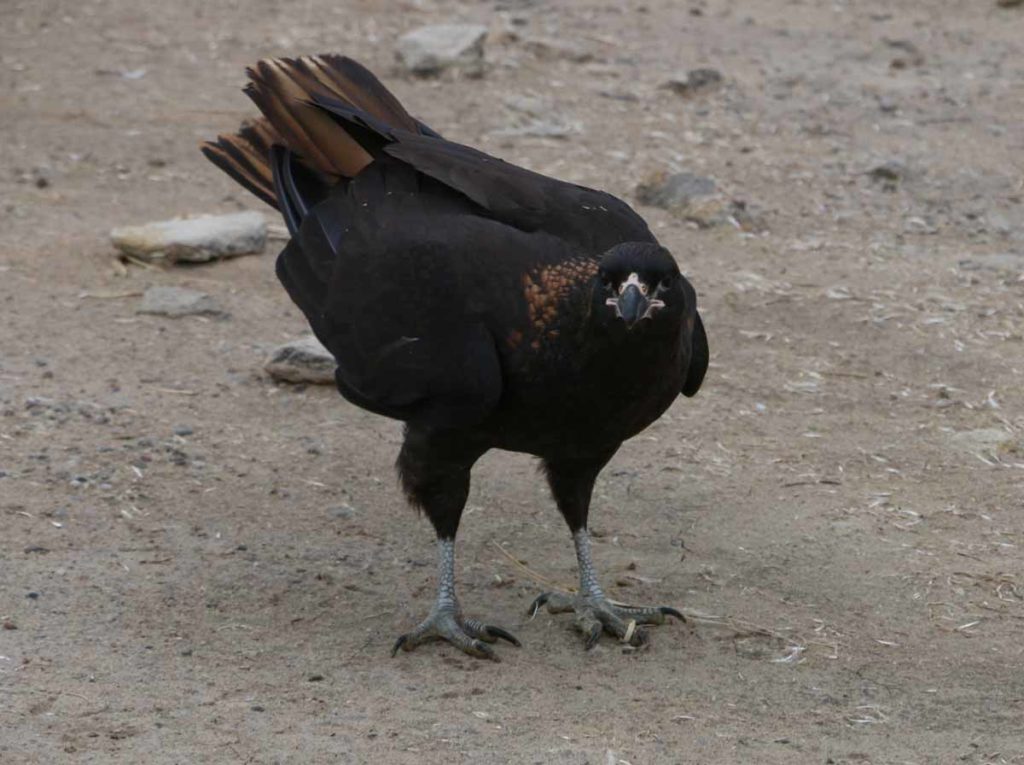
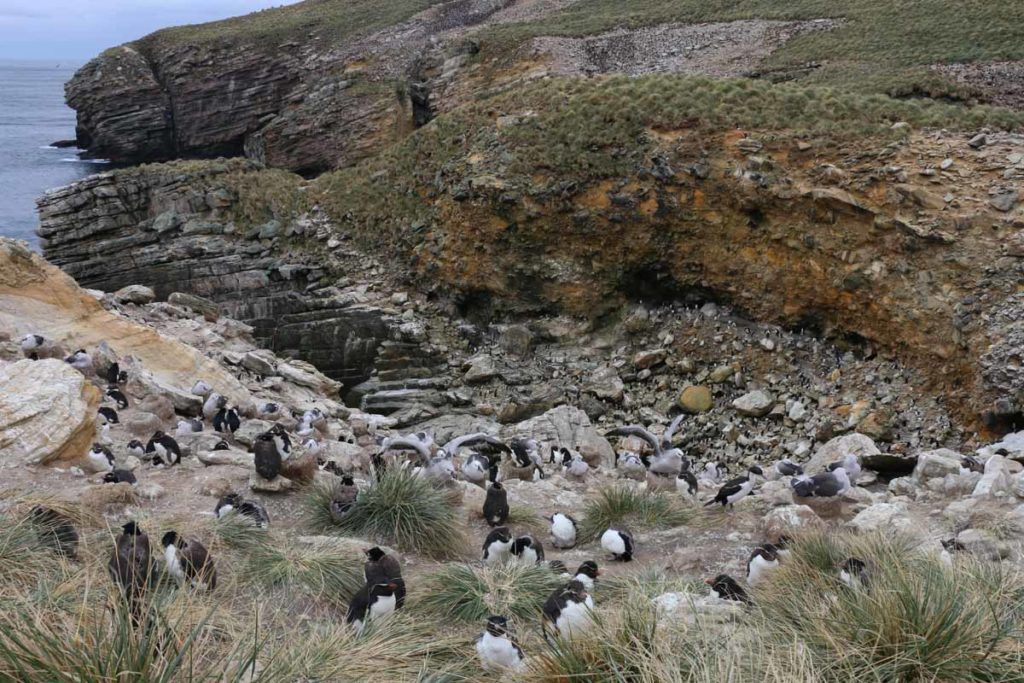
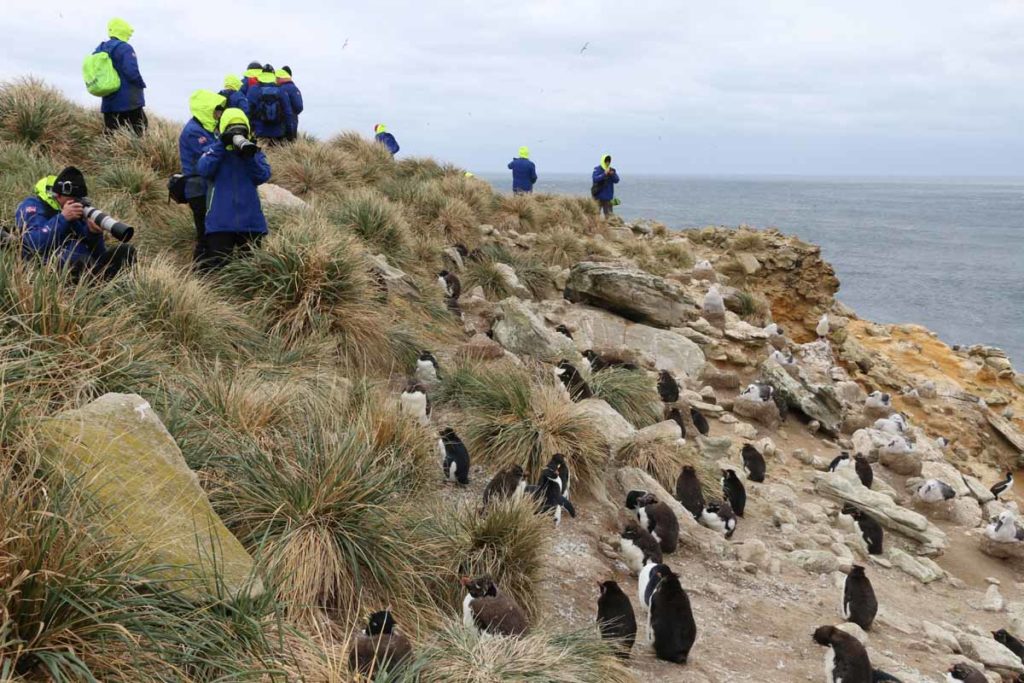
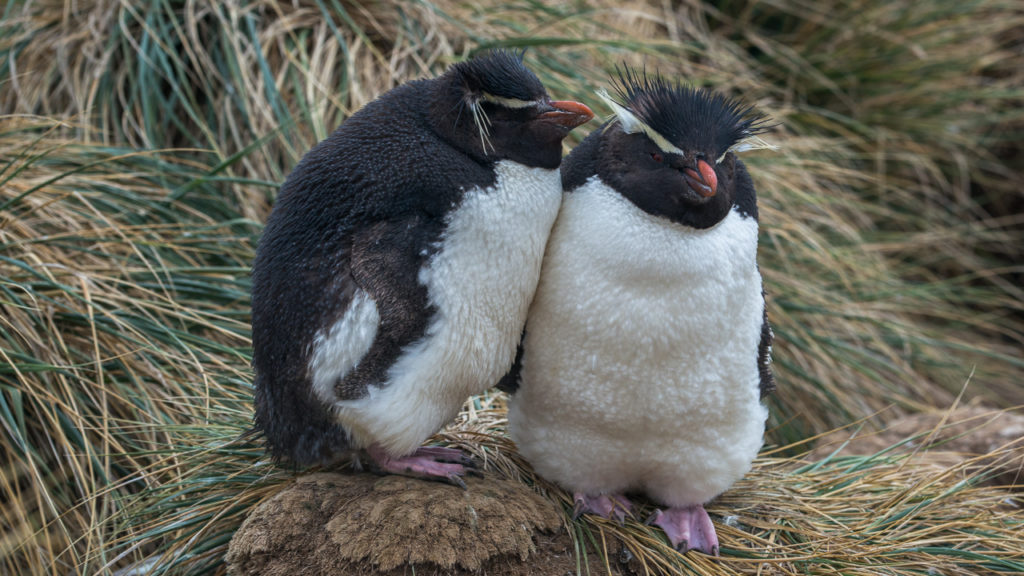
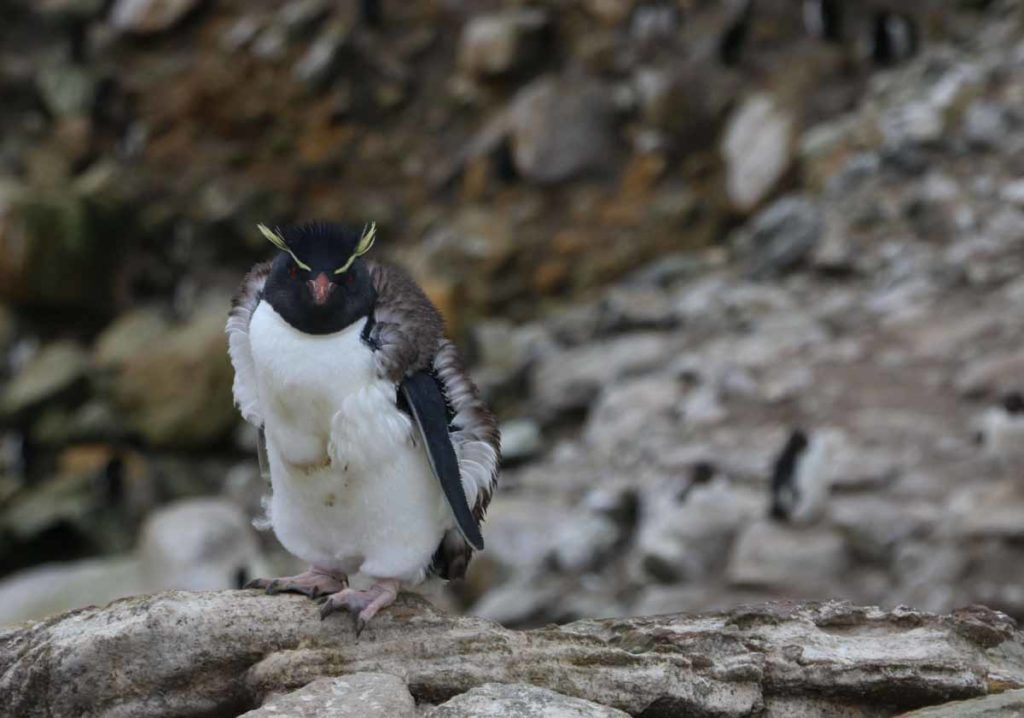
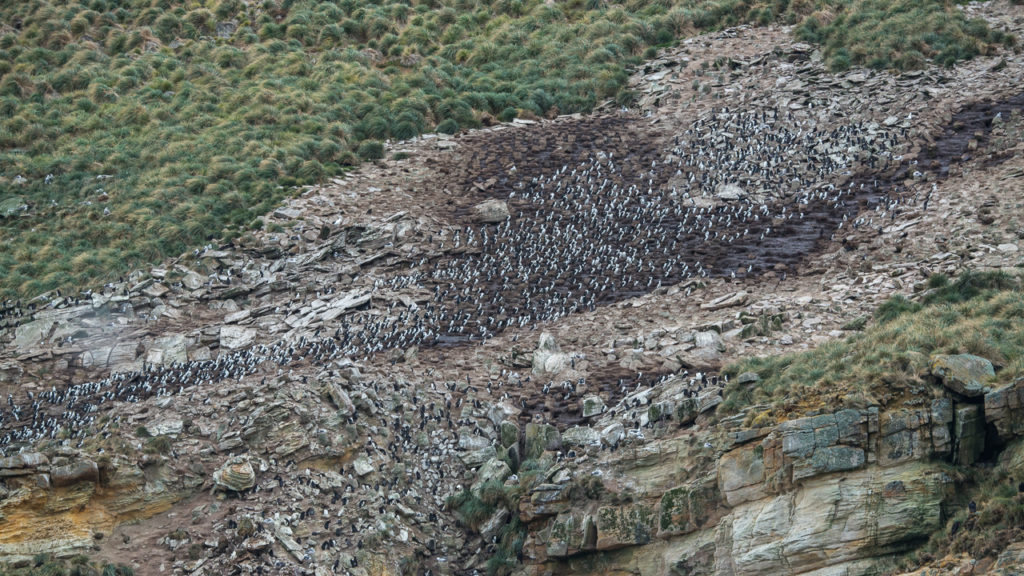
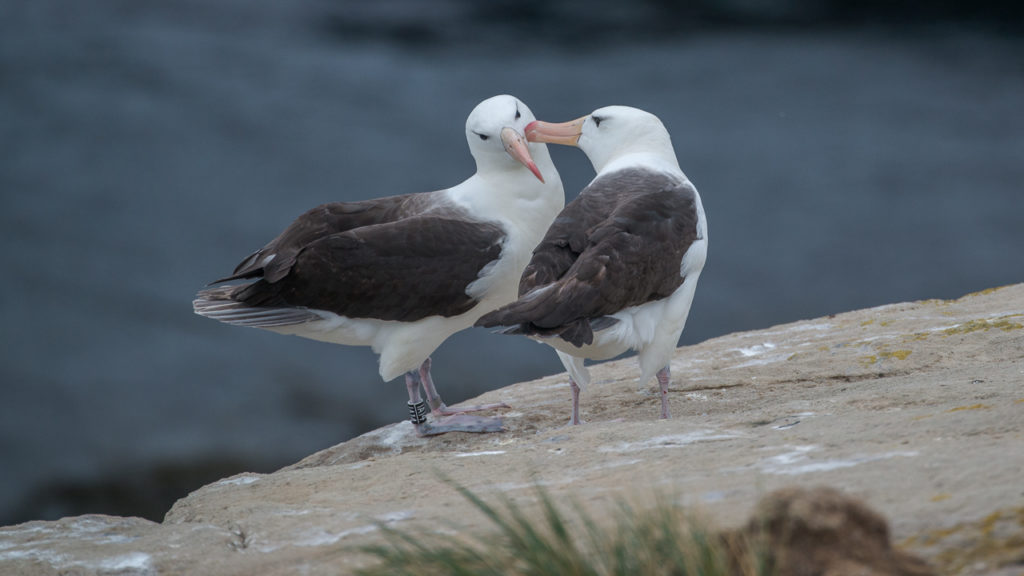
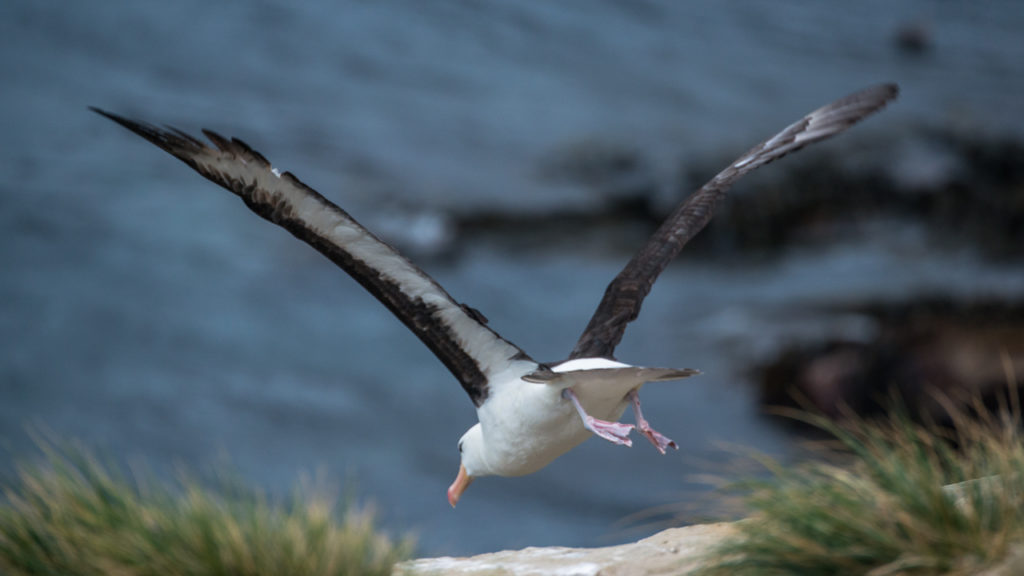
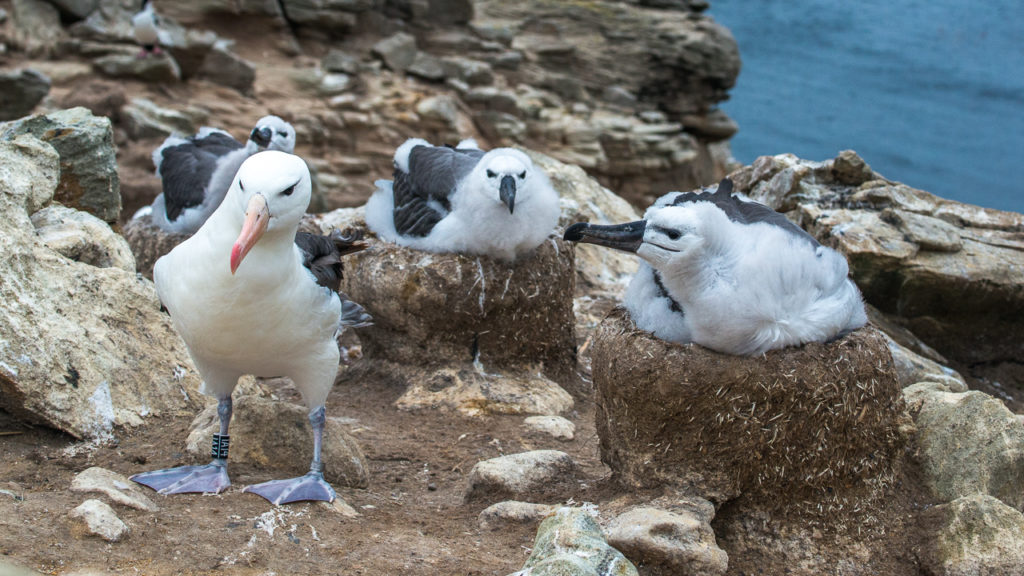
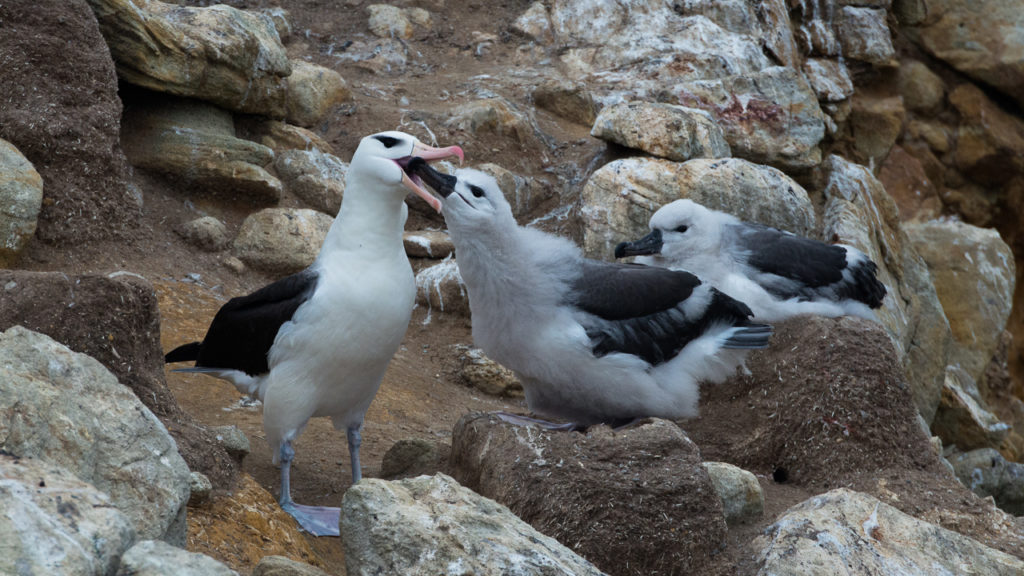
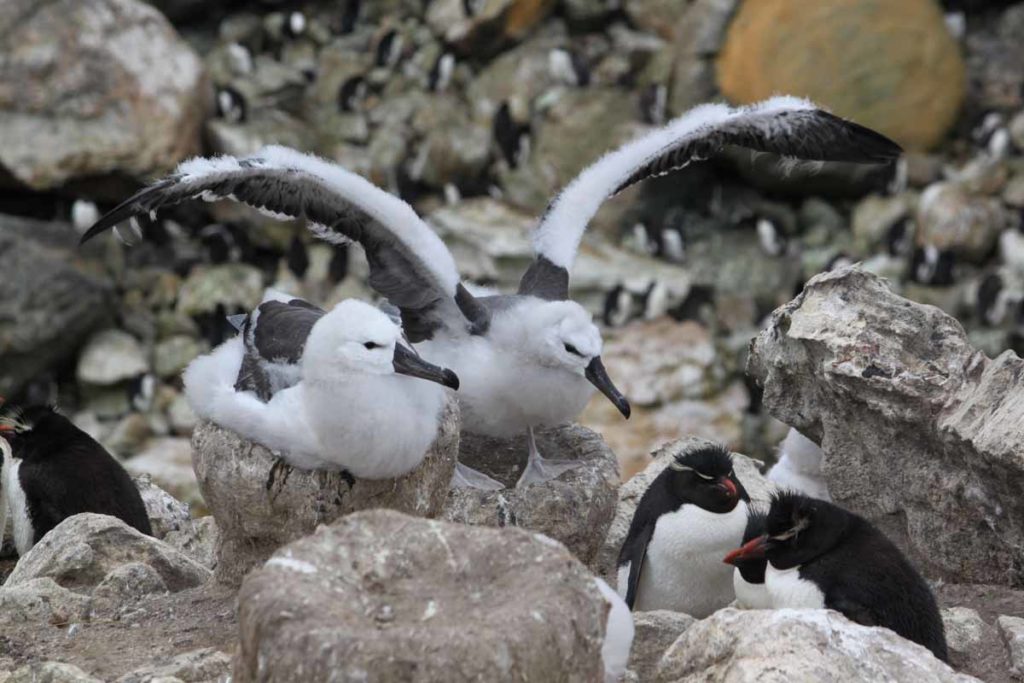
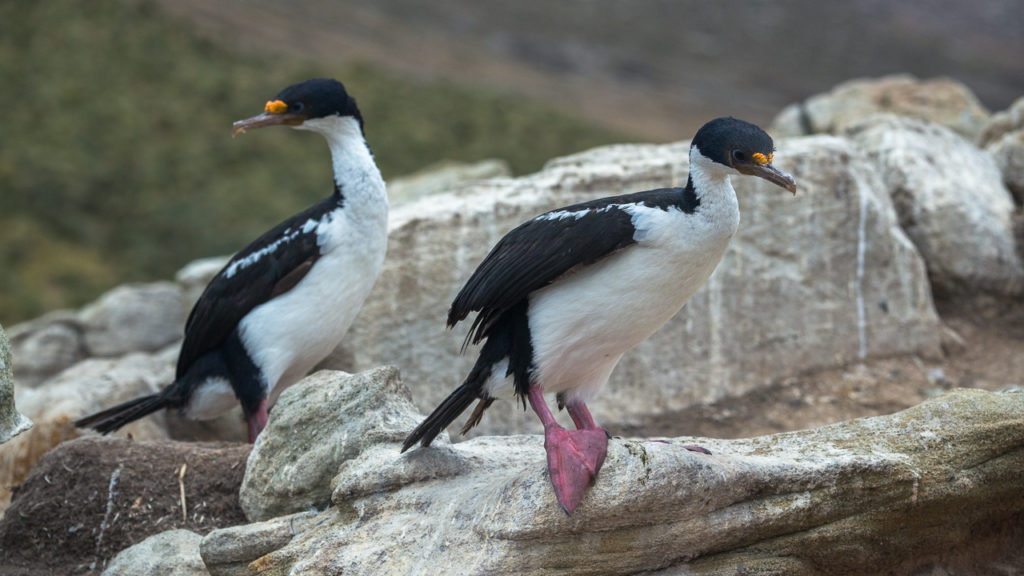
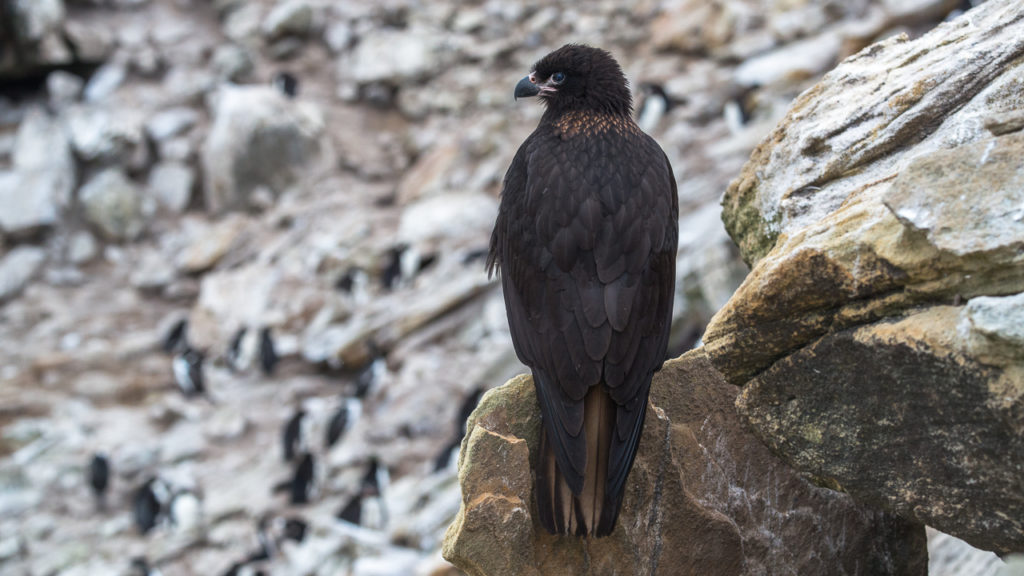
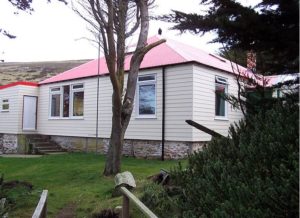
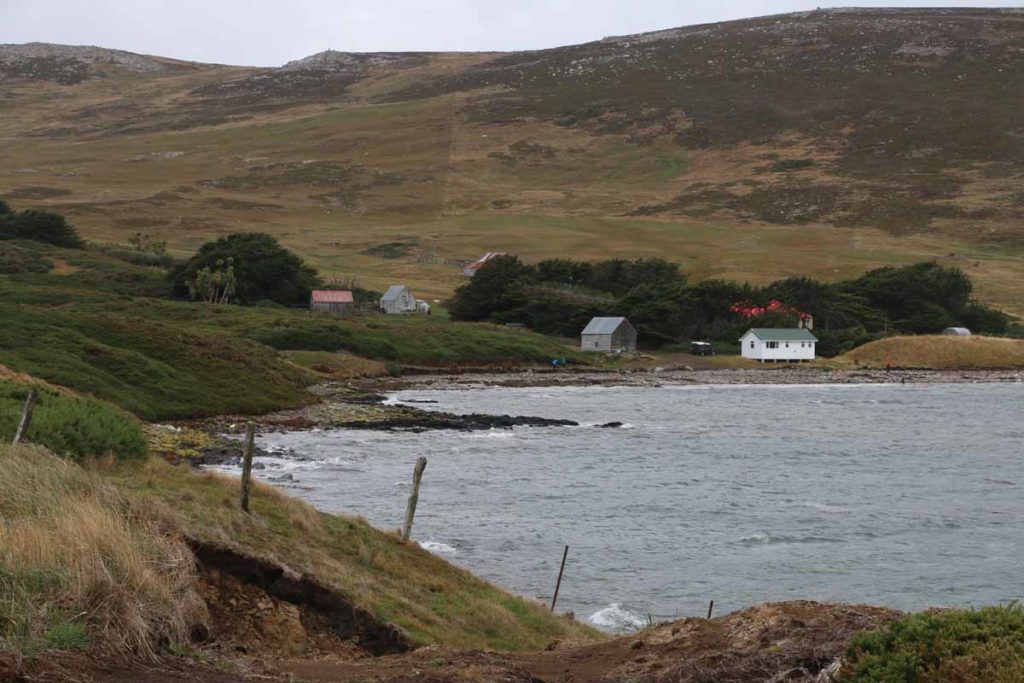
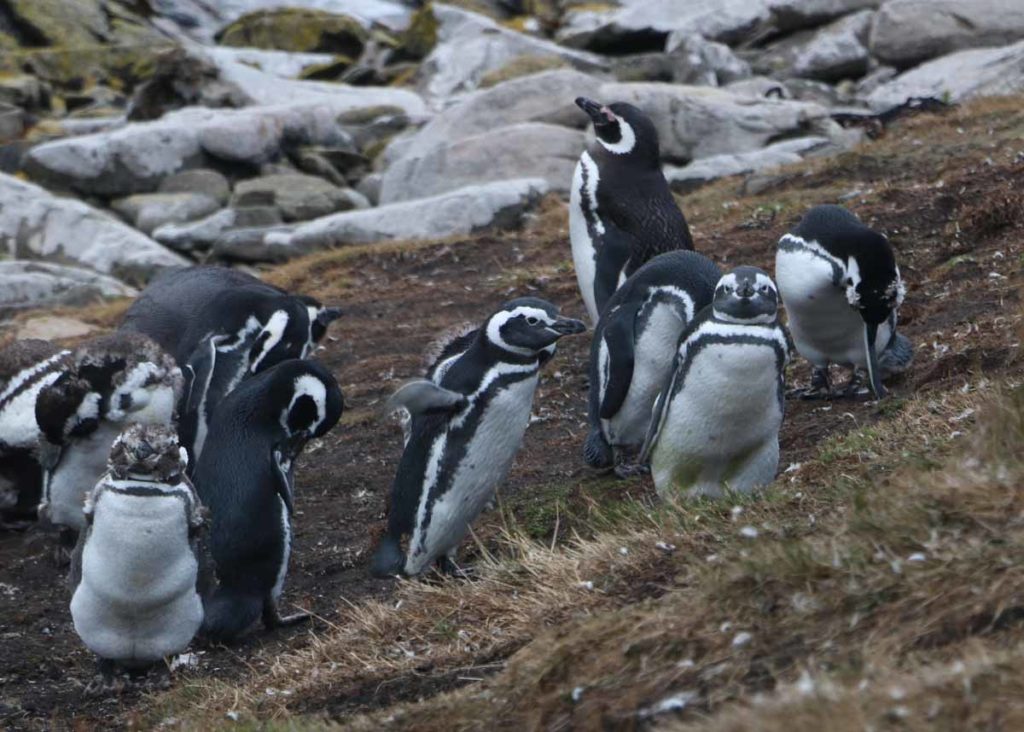
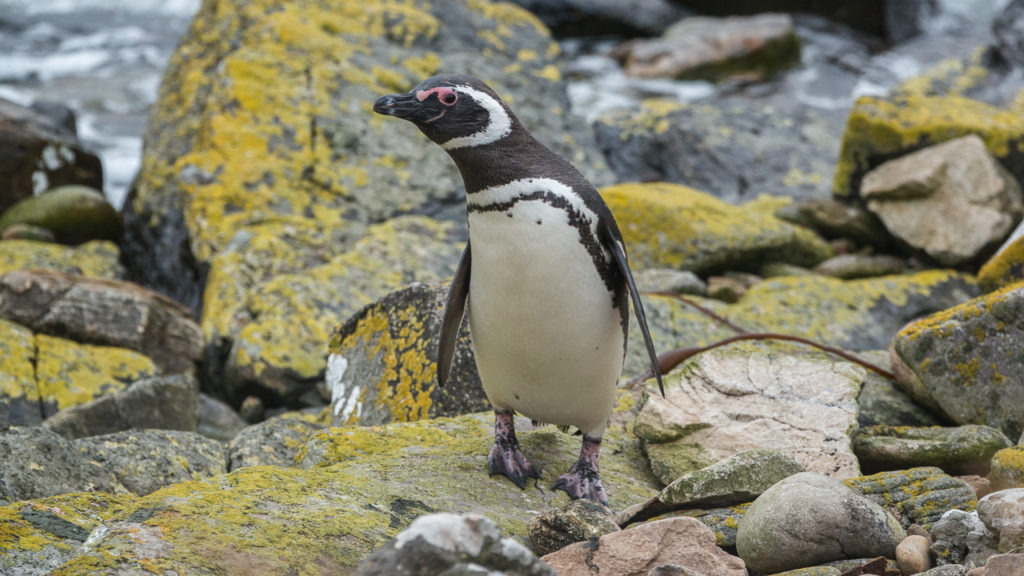
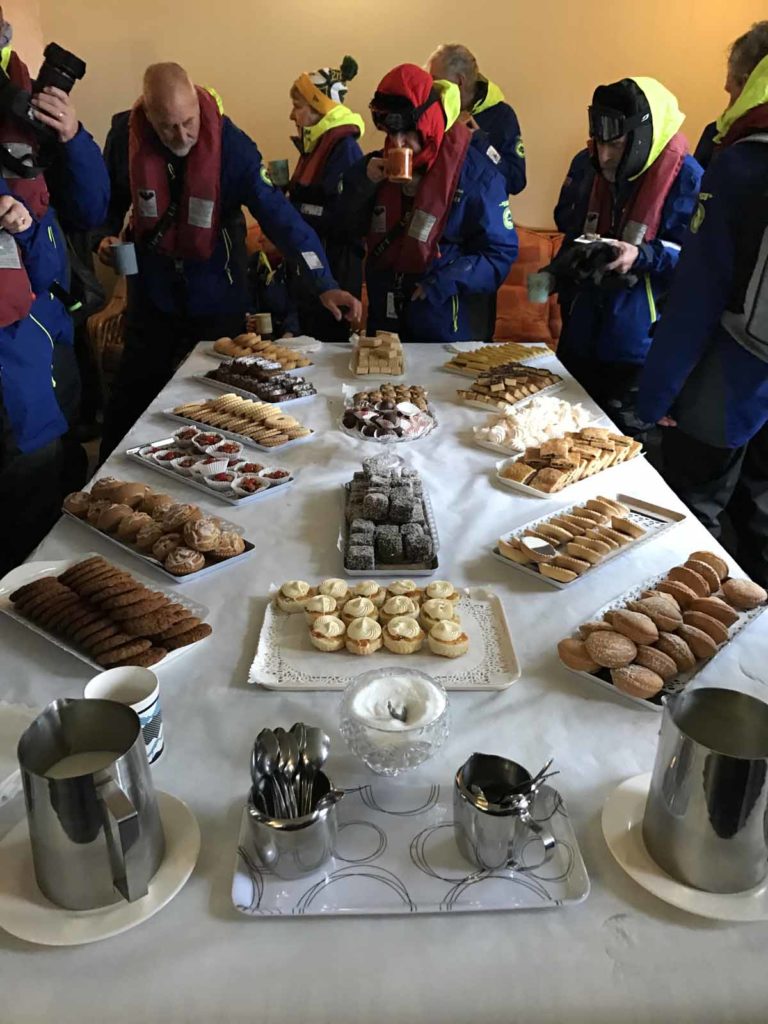
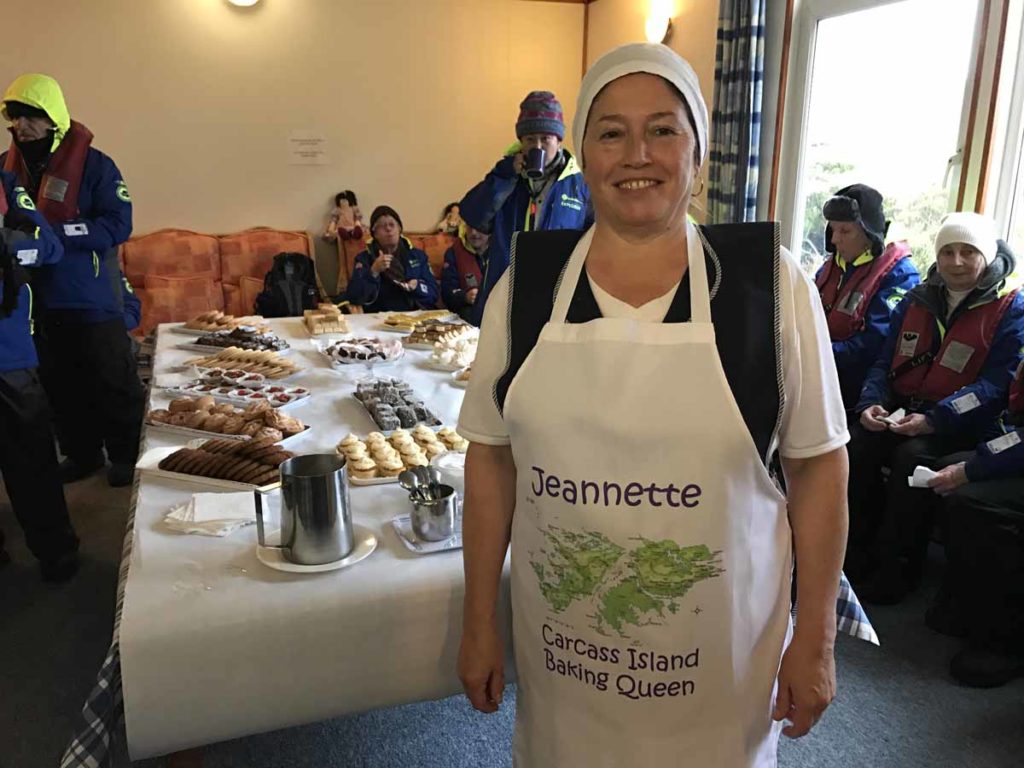
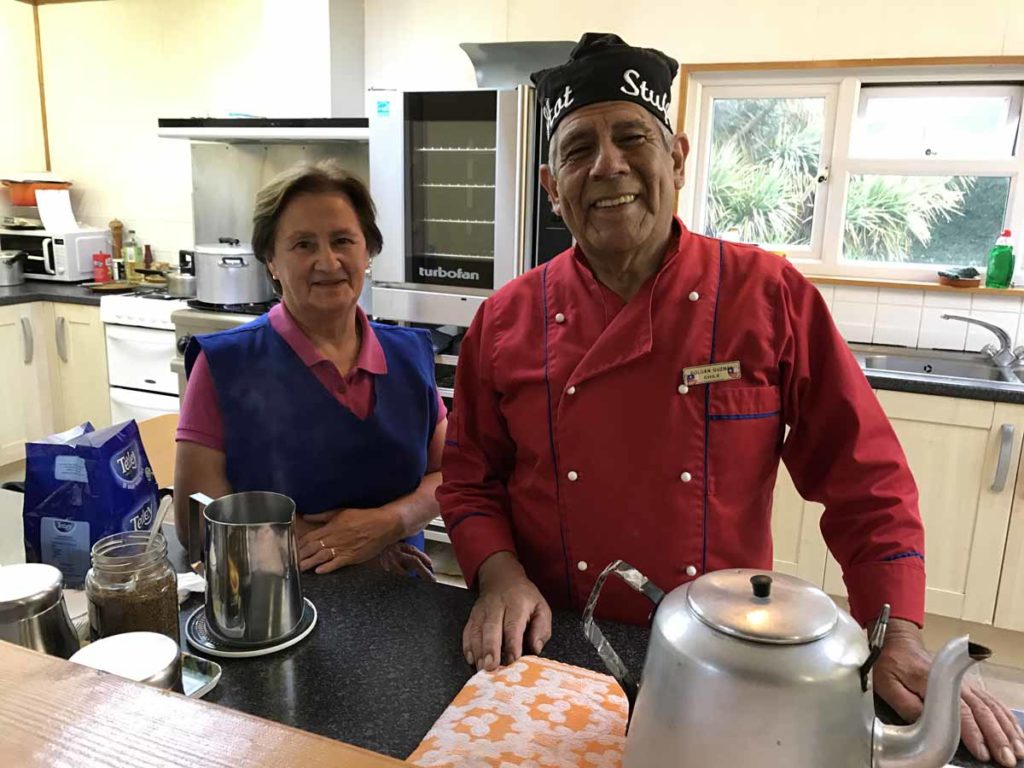
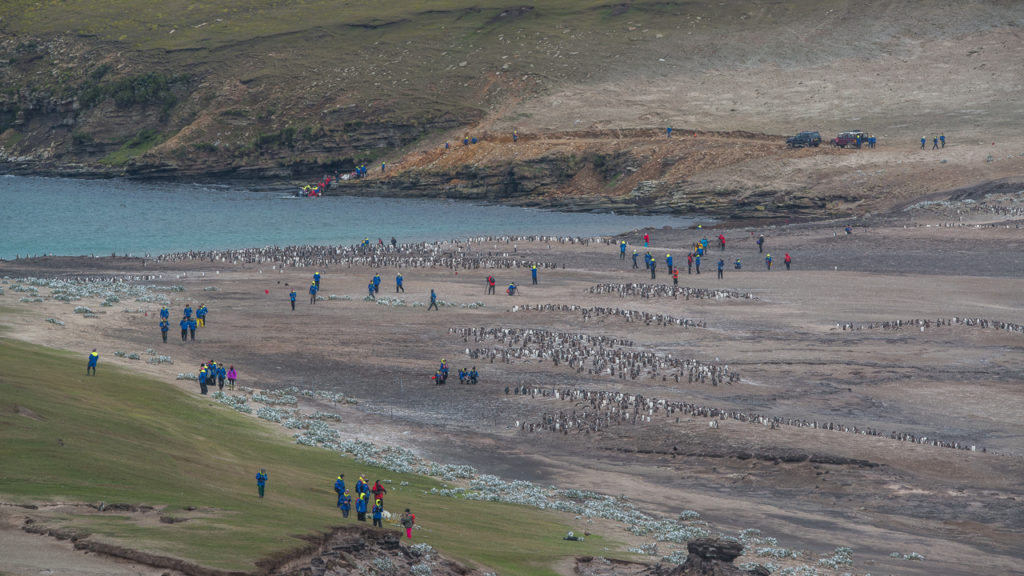
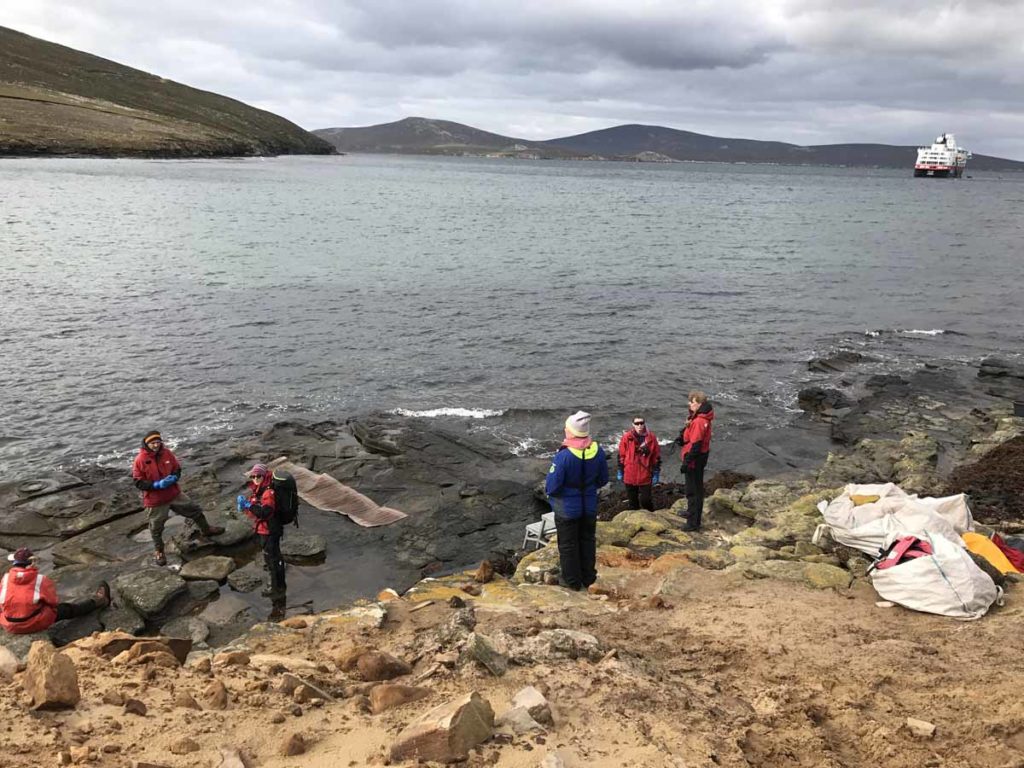
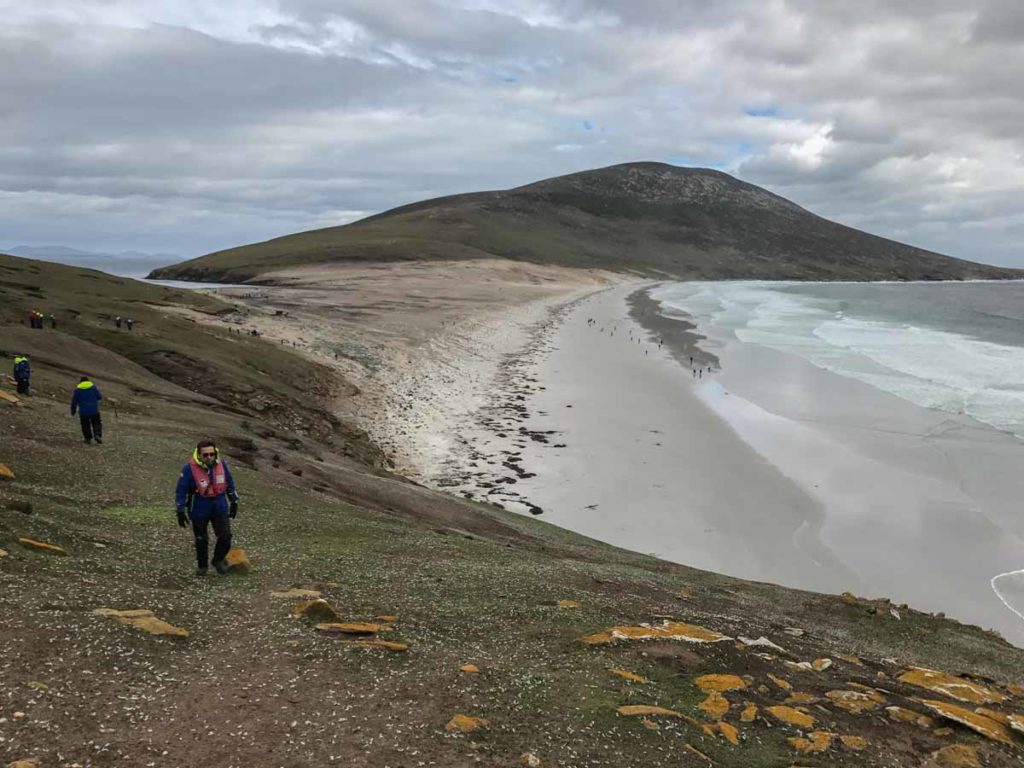
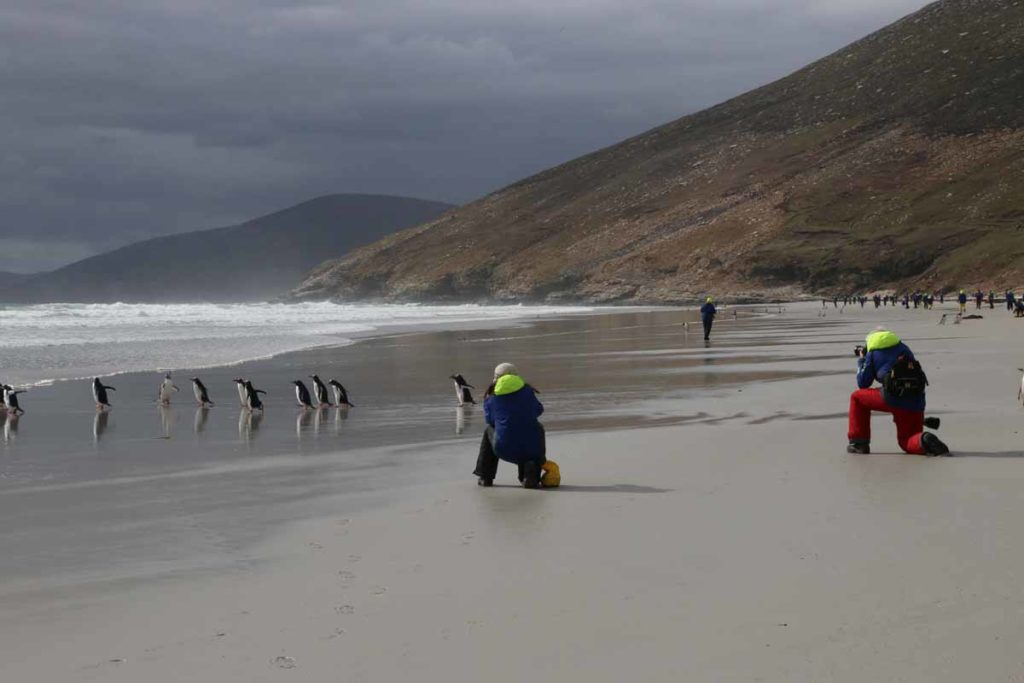
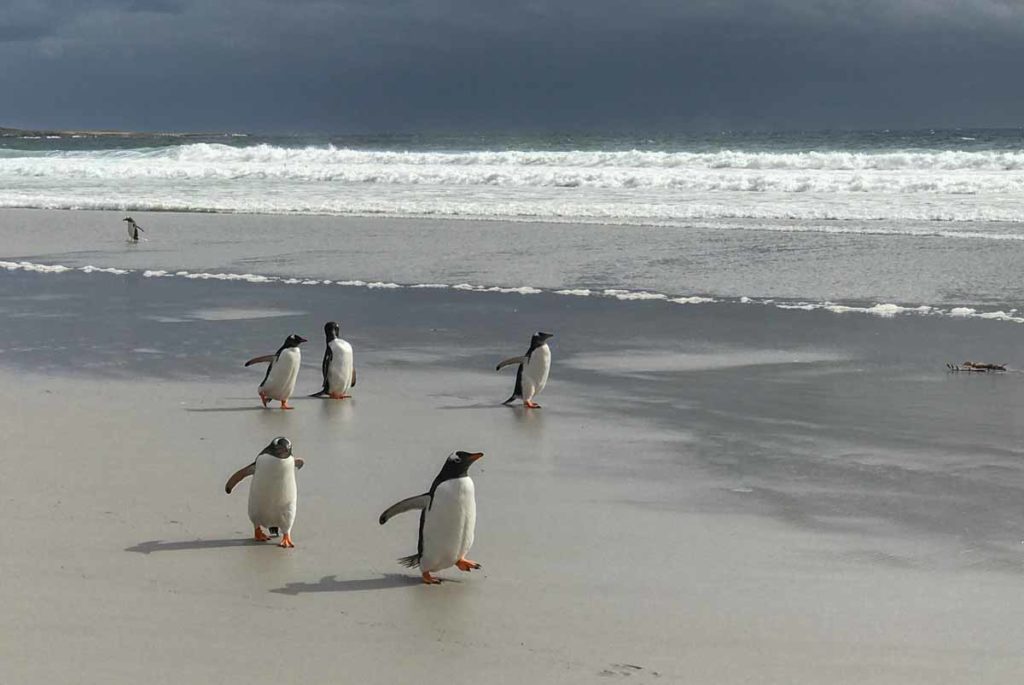
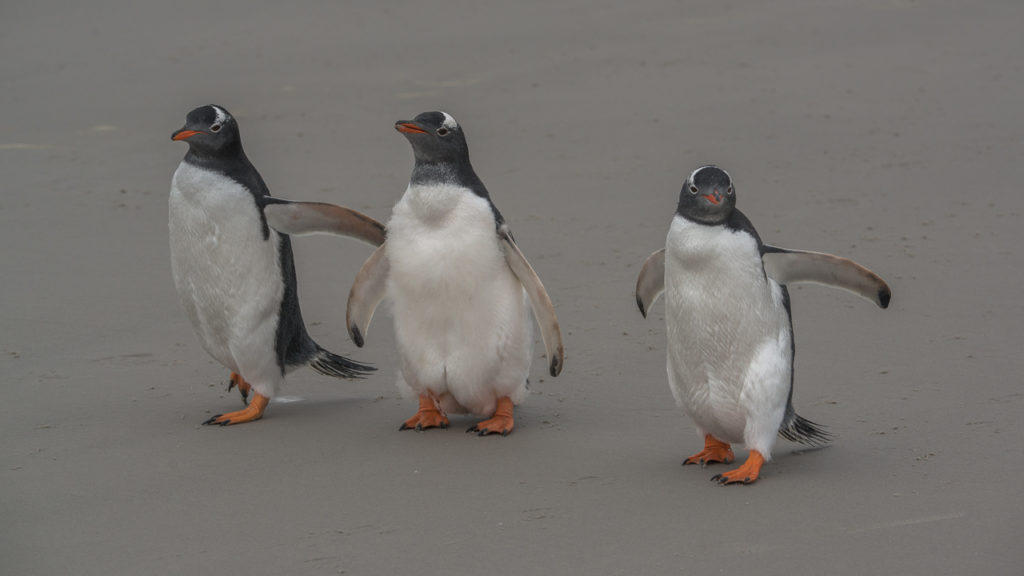
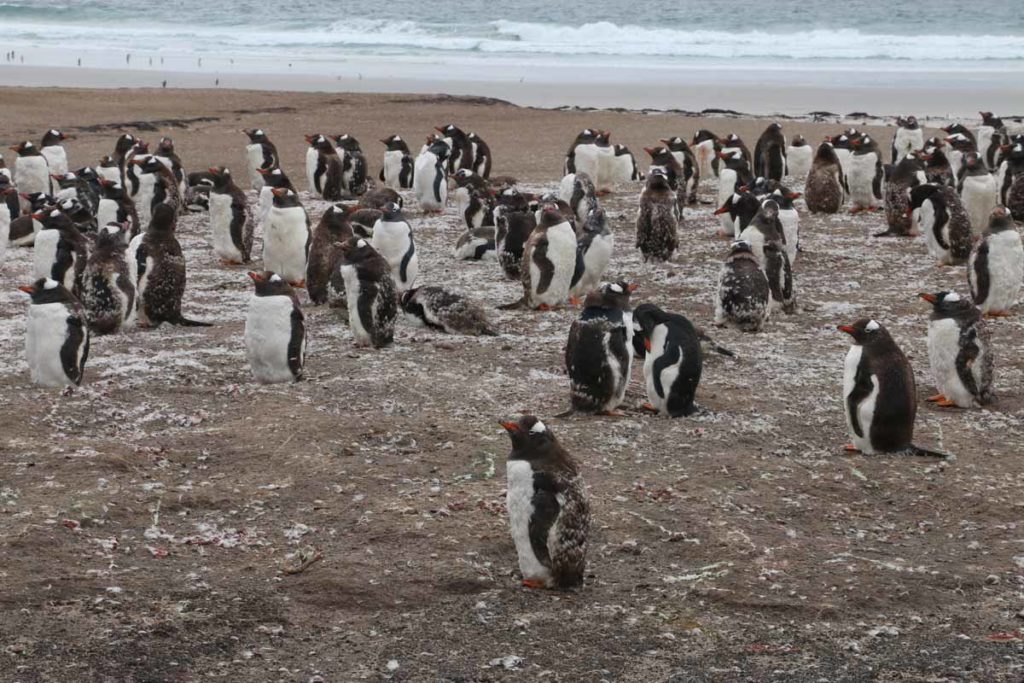
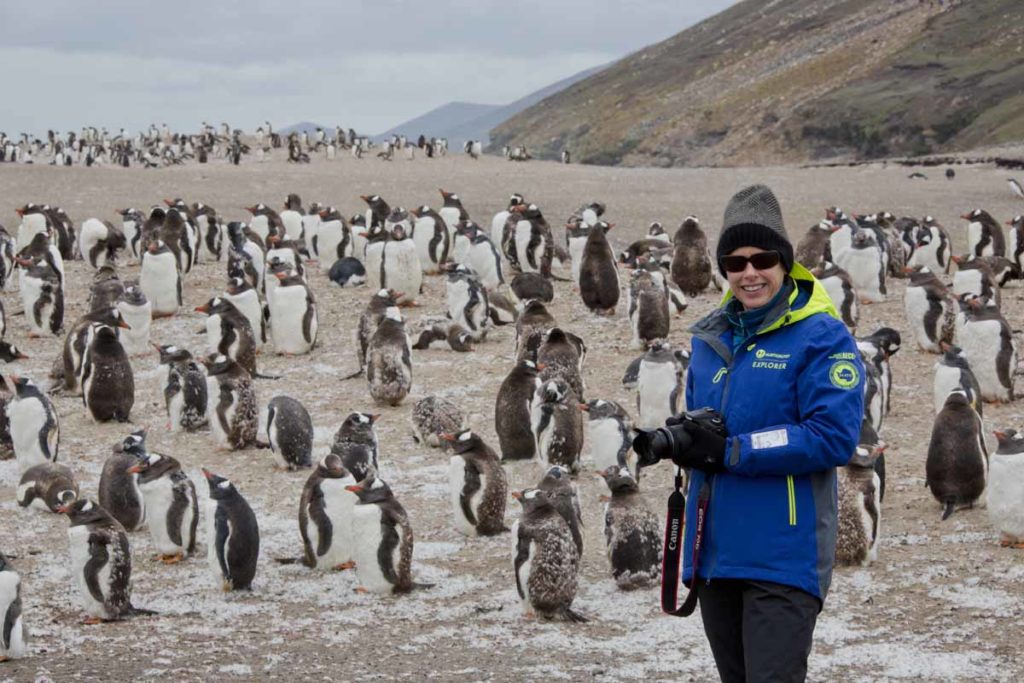
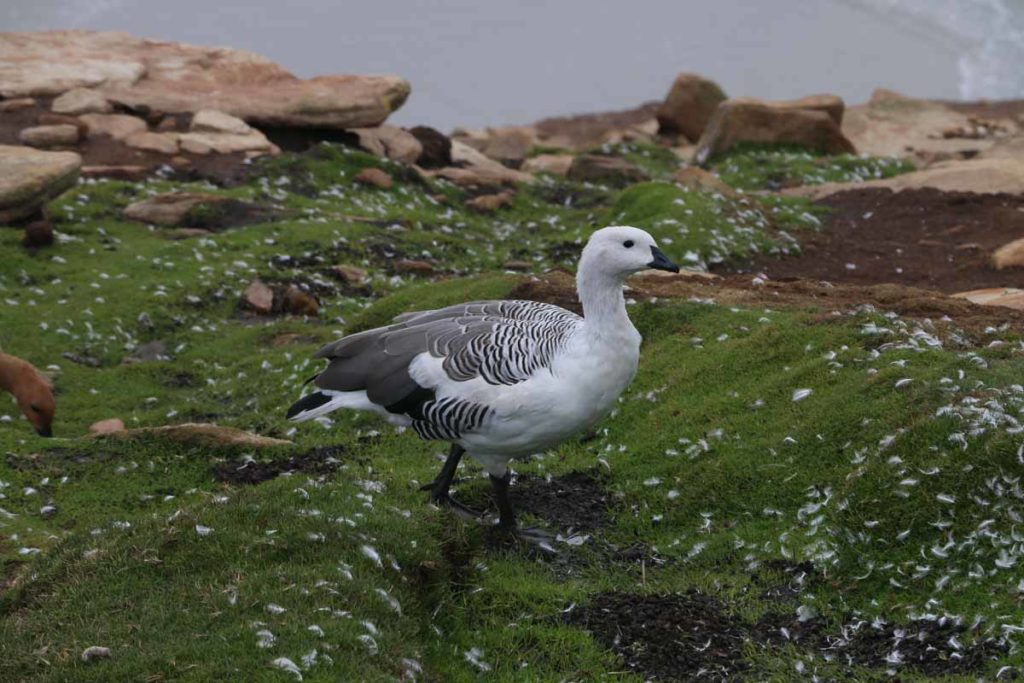
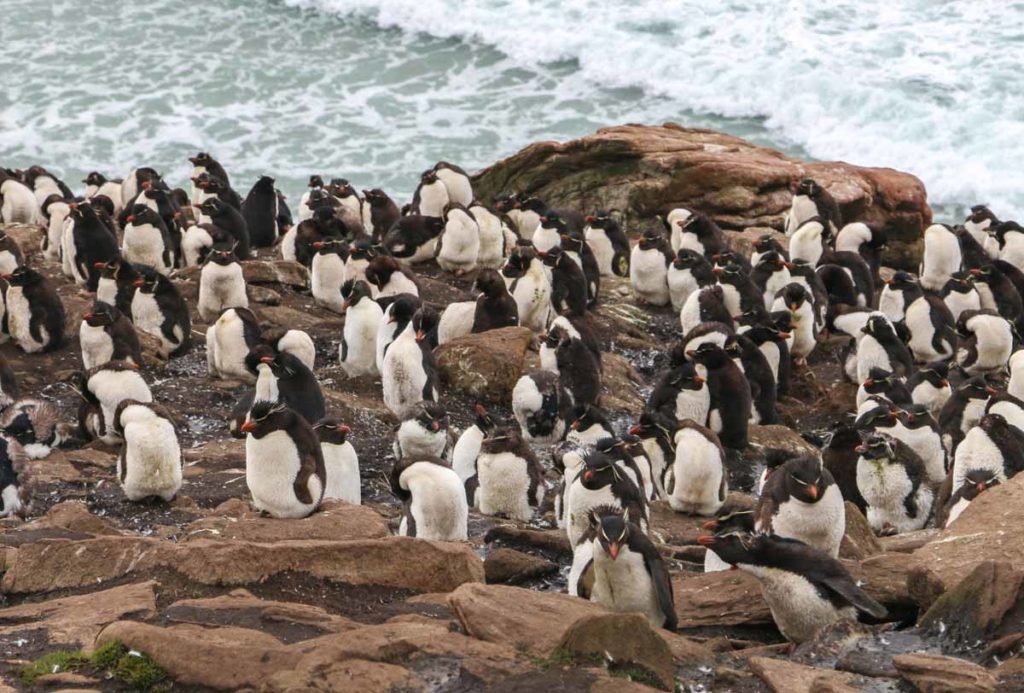
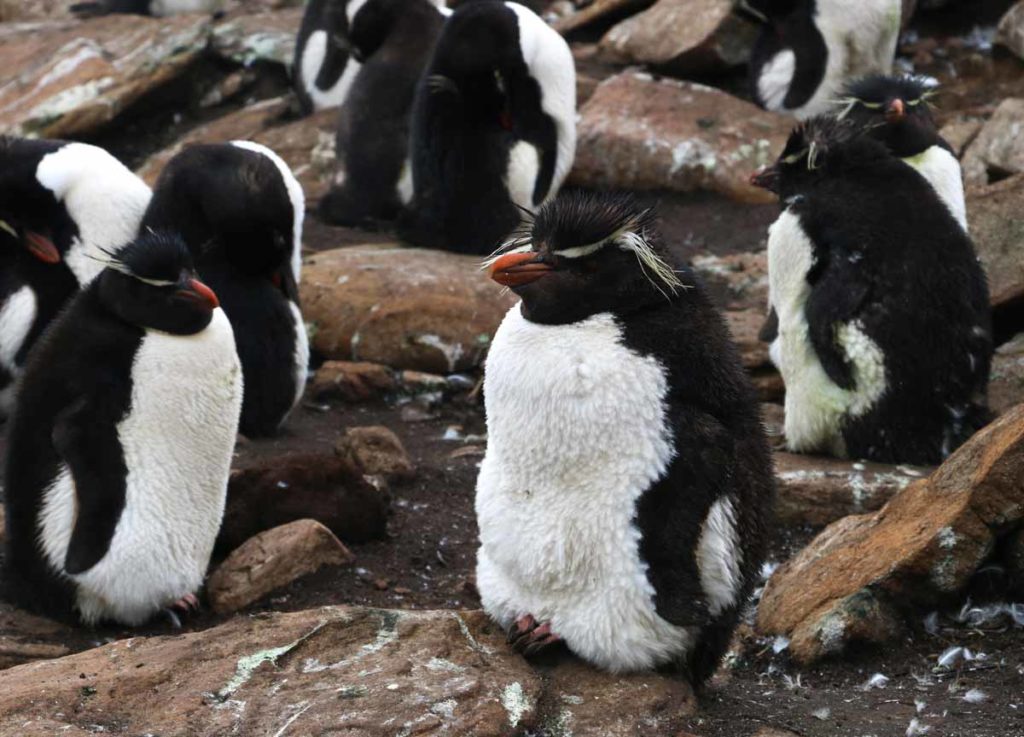
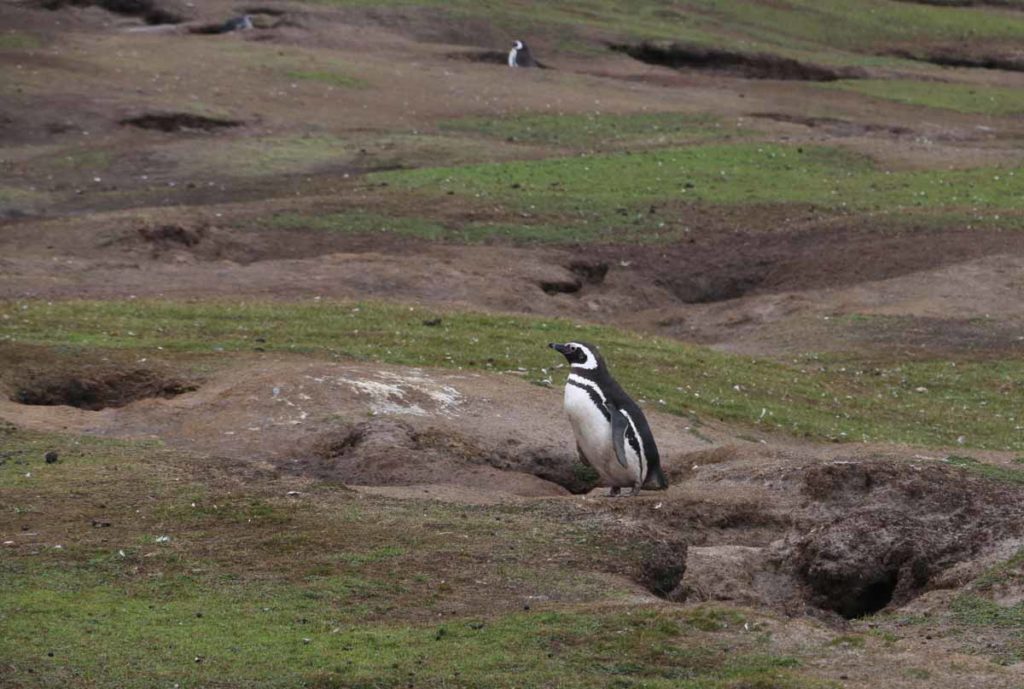
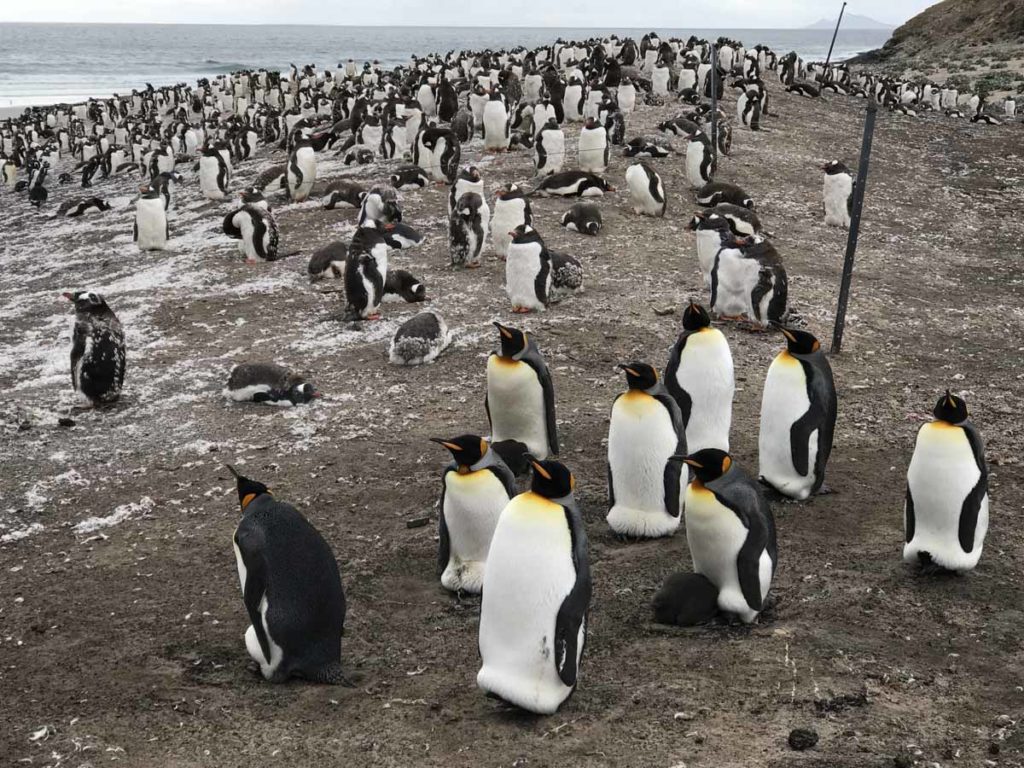
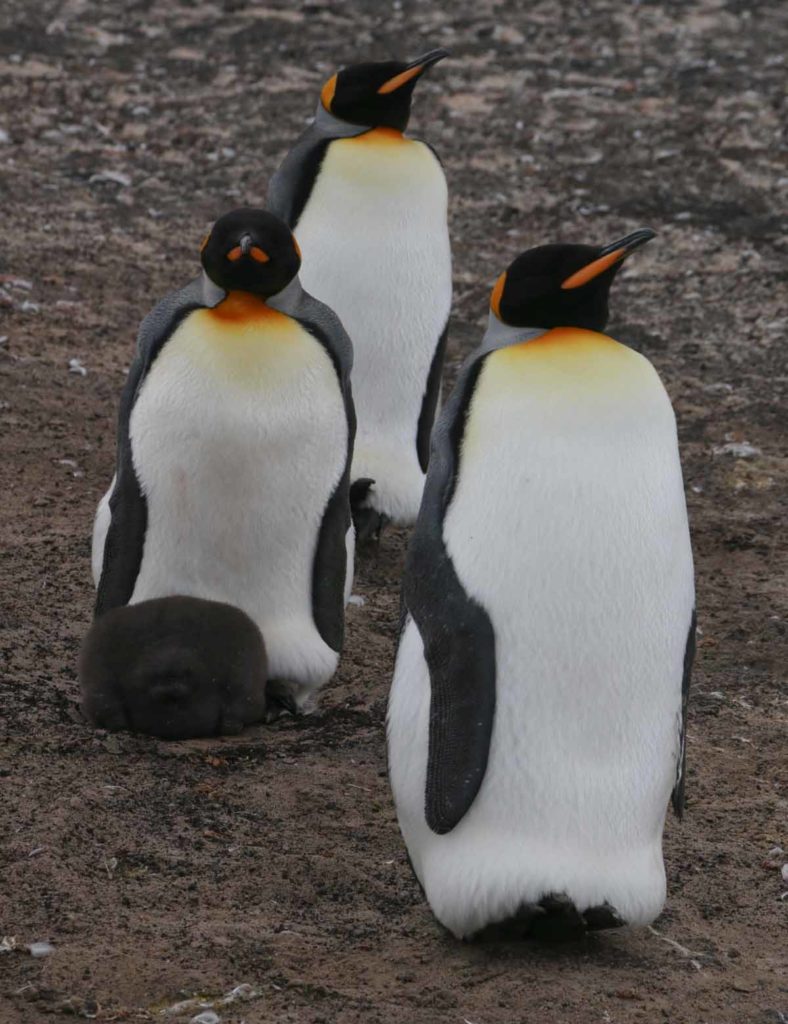
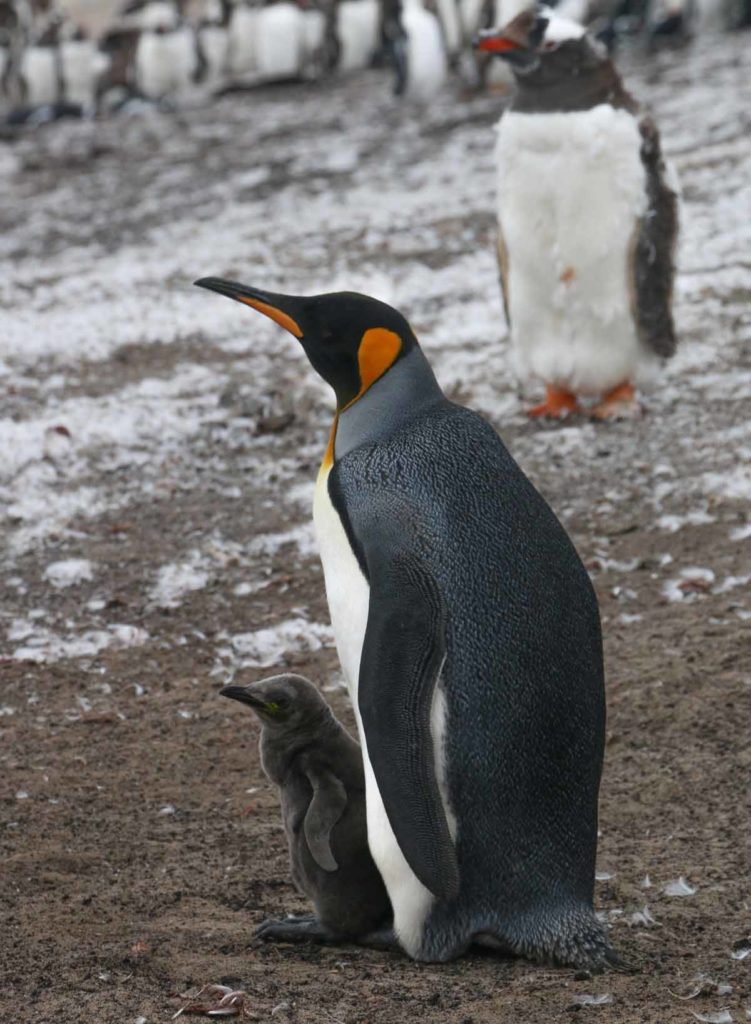
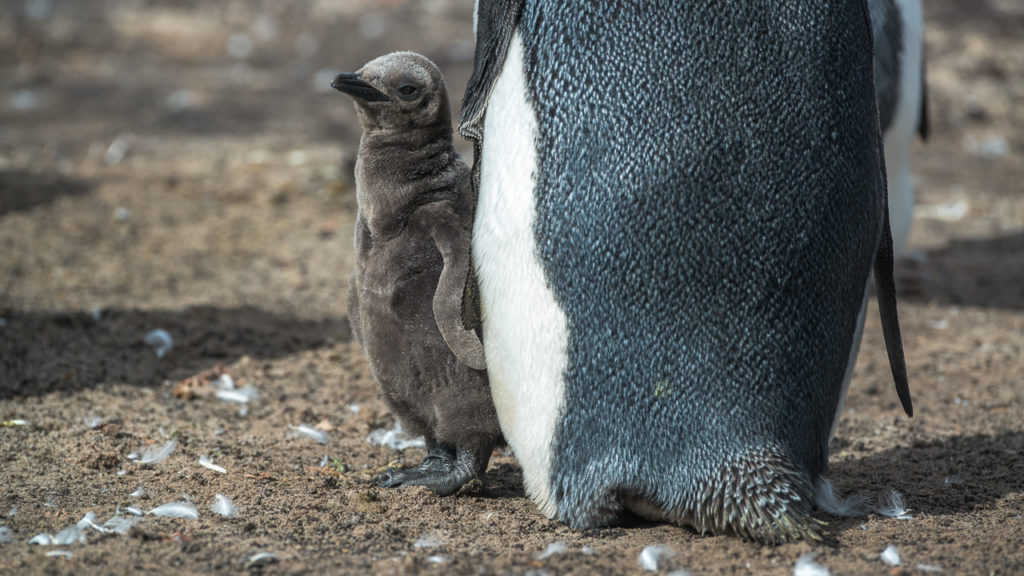
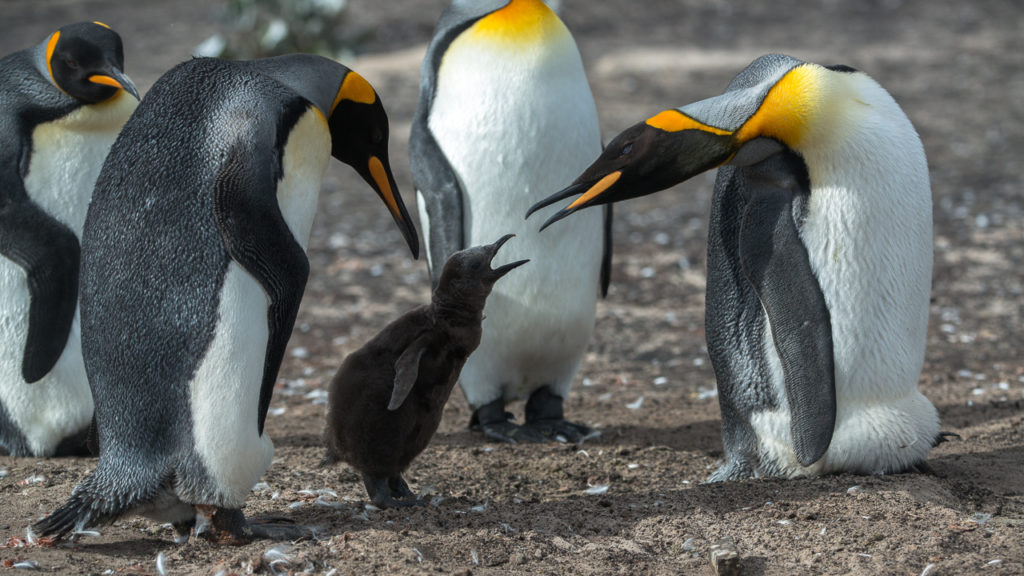
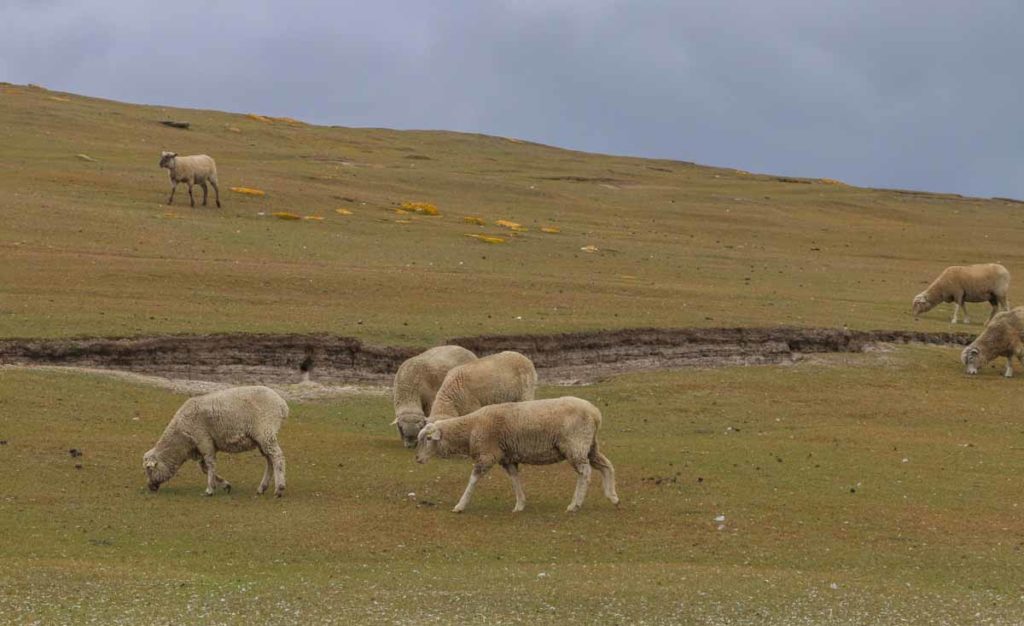
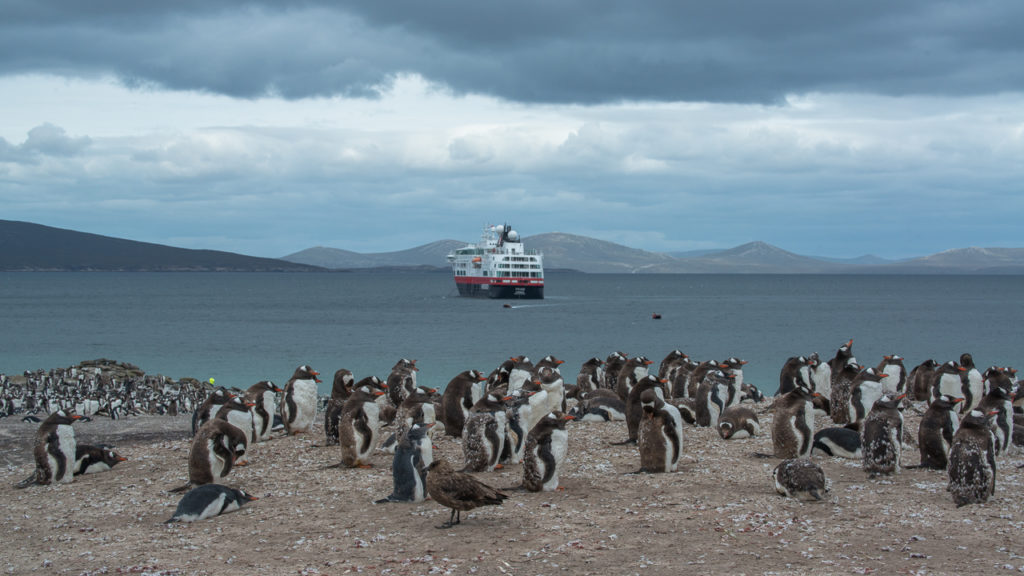
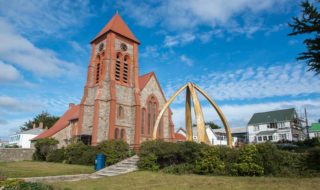
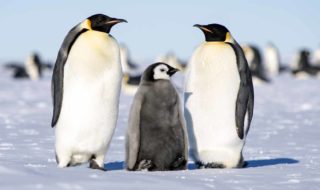
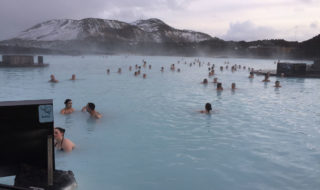
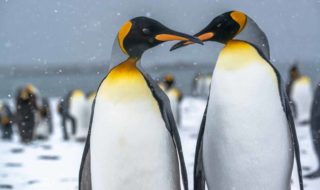
Post a Comment